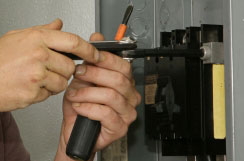 |
 |
Commercial HVAC Portsmouth, VA
Furnaces and Boilers
Most U.S. homes are heated with either furnaces or boilers. Furnaces
heat air and distribute the heated air through the house using ducts;
boilers heat water, providing either hot water or steam for heating.
Steam is distributed via pipes to steam radiators, and hot water
can be distributed via baseboard radiators or radiant floor systems,
or can heat air via a coil. Steam boilers operate at a higher temperature
than hot water boilers, and are inherently less efficient, but high-efficiency
versions of all types of furnaces and boilers are currently available.
Understanding the Efficiency Rating of Furnaces and Boilers
A central furnace or boiler's efficiency is measured by annual fuel
utilization efficiency (AFUE). The Federal Trade Commission requires
new furnaces or boilers to display their AFUE so consumers can compare
heating efficiencies of various models. AFUE is a measure of how
efficient the appliance is in the energy in its fuel over the course
of a typical year.
Specifically, AFUE is the ratio of heat output of the furnace or
boiler compared to the total energy consumed by a furnace or boiler.
An AFUE of 90% means that 90% of the energy in the fuel becomes heat
for the home and the other 10% escapes up the chimney and elsewhere.
AFUE doesn't include the heat losses of the duct system or piping,
which can be as much as 35% of the energy for output of the furnace
when ducts are located in the attic.
An all-electric furnace or boiler has no flue loss through a chimney.
The AFUE rating for an all-electric furnace or boiler is between
95% and 100%. The lower values are for units installed outdoors because
they have greater jacket heat loss. However, despite their high efficiency,
the higher cost of electricity in most parts of the country makes
all-electric furnaces or boilers an uneconomic choice. If you are
interested in electric heating, consider installing a heat pump system.
The minimum allowed AFUE rating for a non-condensing fossil-fueled,
warm-air furnace is 78%; the minimum rating for a fossil-fueled boiler
is 80%; and the minimum rating for a gas-fueled steam boiler is 75%.
A condensing furnace or boiler condenses the water vapor produced
in the combustion process and uses the heat from this condensation.
The AFUE rating for a condensing unit can be much higher (by more
than 10 percentage points) than a non-condensing furnace. Although
condensing units cost more than non-condensing units, the condensing
unit can save you money in fuel costs over the 15- to 20-year life
of the unit, and is a particularly wise investment in cold climates.
You can identify and compare a system's efficiency by not only its
AFUE but also by its equipment features, listed below.
Old, low-efficiency heating systems:
•
Natural draft that creates a flow of combustion gases
•
Continuous pilot light
•
Heavy heat exchanger
•
68%–72% AFUE
Mid-efficiency heating systems:
•
Exhaust fan controls the flow of combustion air and combustion gases
more precisely
•
Electronic ignition (no pilot light)
•
Compact size and lighter weight to reduce cycling losses
•
Small-diameter flue pipe
•
80%–83% AFUE
High-efficiency heating systems:
•
Condensing flue gases in a second heat exchanger for extra efficiency
•
Sealed combustion
•
90%–97% AFUE
Retrofitting Your Furnace or Boiler
Furnaces and boilers can be retrofitted to increase their efficiency.
These upgrades improve the safety and efficiency of otherwise sound,
older systems. The costs of retrofits should be carefully weighed
against the cost of a new boiler or furnace, especially if replacement
is likely within a few years or if you wish to switch to a different
system for other reasons, such as adding air conditioning (see the
section on selecting and replacing heating and cooling systems).
If you choose to replace your gas heating system, you'll have the
opportunity to install equipment that incorporates the most energy-efficient
heating technologies available.
Since retrofits are fuel-specific, see the following sections for
retrofit information:
•
Gas-Fired Furnaces and Boilers (includes units fired with natural
gas and propane)
•
Oil-Fired Furnaces and Boilers
Other retrofitting options that can improve a system's energy efficiency
include installing programmable thermostats, upgrading ductwork in
forced-air systems, and adding zone control for hot-water systems,
an option discussed in the Heat Distribution Systems section.
Also see: Furnace and Boiler
Maintenance and Furnace
and Boiler Replacement
Click here for a free
confidential quotation
Or give us a call today at (757) 333-3114.
|
| |
 Commercial
& Residential HVAC Commercial
& Residential HVAC
Commercial & Residential Service Provider
in Portsmouth, VA
|
|
|

